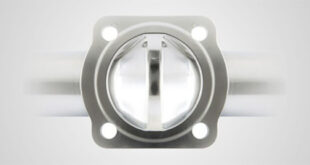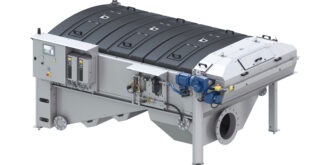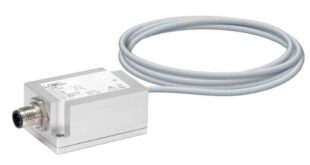Food processing and packaging equipment is subject to stringent and ever-increasing safety requirements. The washdown processes required for equipment cleaning and sanitising are especially critical for food processing applications featuring a ‘wet’ area, for example, cheese, fish, meat, or dairy processing. Selecting the correct motor for processing equipment and applications plays a vital role in ensuring that washdown can be handled safely and efficiently. Bunnyray Larmond reports
Food manufacturing and processing facilities conduct a complete washdown at the end of each shift and when other events trigger cleaning such as an unexpected spill or product changeover.
The required multi-stage washdown process outlined below is issued by the National Sanitation Foundation (NSF) covering step-by-step guidelines on how to clean and sanitise food processing and handling areas where the possibility of contamination could exist1.
Remove debris.
Rinse all residues with warm potable water.
Apply detergent and a good scrubbing with properly mixed chemical cleaners.
Rinse thoroughly to completely remove the detergent and any residue.
Inspect and spot clean any areas where there are still visible signs of residue or detergent.
Sanitise or disinfect with a chemical verified suitable to use for food and beverage processing or handling environments.
Dry by completely removing rinse-off sanitiser or disinfectant with a potable water rinse.
To understand if a motor used in an application with a washdown process can withstand the requirements, ratings such as ingress protection (IP) have been developed and implemented.
Ingress protection ratings used to ensure equipment can survive washdown
Washdown motors must meet ingress protection (IP) ratings that ensure they can survive and thrive in the type of cleaning processes that is needed. The IP code indicates how well a device is protected against water and dust. It is defined by the International Electrotechnical Commission (IEC) under international standard IEC 60529, which classifies the degree of protection provided against intrusion, dust, and water2.
The IP rating is typically expressed with a two-digit number, with two optional additional/supplementary letters. The first digit represents solid particle protection, which is the level of protection provided against access to hazardous parts and the ingress of solid foreign objects. The second digit is liquid ingress protection, indicating the level of protection provided against harmful ingress of water.
Using the right equipment to navigate the washdown procedure is critical for wet areas in food and beverage processing and packaging applications. A wet area is where water activity, usually water circulation, steam, pasteurisation, or sterilisation is present. Typically, these involve meat, fish, or the dairy processing industries. IP ratings in wet areas generally require the first digit to be a six, representing complete protection against solid foreign matter (dust-tight). By contrast bakeries or cereal processing would typically use a motor with a first digit of five, wherein dust ingress is not entirely prevented but does not interfere with safe operations.
For wet areas in food and beverage processing, the second digit is typically either a 5 (IP 65), providing protection from a hose down but not a direct spray; 6 (IP 66), such that the equipment provides protection against water projected in powerful jets; 7 (IP 67), protecting from immersion up to 1 meter (3ft 3in) depth; or 9K (IP 69K), providing protection against powerful high-temperature water jets using caustic chemicals.
Many companies are moving towards selection of higher IP ratings on food processing equipment in response to the trend towards stricter sanitising/cleaning requirements. Machine designers are also leaning towards less complex and easier to clean machines to reduce downtime and cost. To do this, they are removing components such as shrouds and couplings that have traditionally been used with lower IP-rated motors and are instead leaving the motors exposed to the washdown process. Therefore, the demand for higher IP rated motors has increased with machine designers’ intent for less complex machines.
Selecting among the available washdown-rated motors and gearmotors types
Most modern washdown-rated motors are made of stainless steel, which is easy to clean and sanitise. Stainless steel provides the corrosion resistance necessary to withstand the harshness of the washdown process. Usually, the 300 series is preferred in motor construction due to its higher corrosion resistance, with 304 and 316 being the most popular grades. In some cases, the 400 series or 17-4 series stainless steel may be used for the motor or gearbox shaft since that material can be hardened. It should be noted that the industry in general is leaning away from coatings such white epoxy paint, because the coating eventually breaks down and flakes, bringing fears of motor failures and/or food contamination.
Even with criteria such as high IP ratings and stainless-steel construction, there are a variety of motor options to choose from to meet the requirements of the application.
Drum motor – Commonly found powering conveyors in food processing applications, drum motors include the motor and gear reduction housed in one cylinder that is used to power conveyor belts. Motion is driven by rotating the outer shell. Advantages to this type of motor are reduced components for the final customer but, at the cost of being highly specialised for use only in conveyor systems.
Servo motor – A servo motor is an electromechanical device that produces torque and velocity based on the supplied current and voltage. A servo motor works as part of a closed loops system, which is comprised of a motor, feedback device, and servo drive providing important feedback on aspects such as position, velocity, or torque. This motor option is commonly found in applications that require high levels of precision and movement, for example, robotic arms. Advantages for servo motors lie in the closed loop feedback for precise motion control. However, they are typically a higher cost to install and maintain because of the required auxiliary components such as specialised cabling and drives.
AC induction motor – Unlike a servo motor that can be programmed for precise motion, an induction motor is used in applications that only require simple on/off and operation at a specific speed. Most washdown rated induction motors are a bit more sophisticated, and can operate as inverter duty motors, which means one can vary the speed and direction of the output shaft when connected to a variable frequency drive. Advantages to this style motor are that they are typically very cost effective because of global standardisation but are less efficient, larger, and limited in motion control.
Gear reducers – Both induction motors and servo motors by design produce a high level of RPM output but low torque. A gearbox typically will reduce the speed of the output while proportionally increasing the torque so higher/heavier loads can be moved. Servo Motors will often take advantage of gearboxes to reduce inertia mismatch between the size of the motor and the load for smooth transitions between motion profile steps. Induction motors have a set speed based on the number of electrical poles and the frequency of the AC current being supplied so a gearbox is normally required to achieve the desired speed of the application.
Right angle gearmotor – A right angle gearmotor takes the mechanical energy created by the motor and transmits it 90 degrees via the gear reducer. This is a very common configuration because it allows the motor and gear reducer footprint to align well with the profile of the machine, shown in the image on the next page. Worm gearing, the most prevalent form of gearing when constructing a right-angle gearbox, allows for self-locking gearboxes based on gear design and ratio. That feature is often desirable when systems are required to stop and resist motion if there is no power to the gearmotor, however this comes at a cost to efficiency, generally meaning a larger motor is required for the same output torque versus alternative gearing designs.
Inline/parallel shaft gearmotor – In the inline/parallel shaft configuration, the output shaft from the gearbox is parallel to the motor shaft. A unique washdown product in this category is Bison’s SANIMotor, which combines both the motor and gearing in one stainless steel shell. Unlike the drum motor, the shell does not rotate, but instead uses an inline output shaft to transmit power. The SANIMotor has two major benefits: the gearing and motor are combined into one unit, which reduces cost; and it reduces the number of areas in which food, waste, and bacteria can accumulate. Inline gearing is commonly more efficient and cost effective than right-angle gearing, but it does now allow for the same mounting flexibility/footprint as right-angle gearing to reduce the machine profile.
Washdown motors in action
Each motor type listed has a variety of advantages and disadvantages for specific applications. However, several types, including the Bison IP69K stainless steel inline and right angle gearmotors, out-perform others due to their efficiency, robust engineering, and flexible design that can be modified to meet specific customer needs.
For example, Bison IHP washdown motors feature corrosion resistant coated rotor and stator, IE3 efficiency for motors greater than 1 HP, and Viton O-rings and seals. They are made of a 316L stainless body and 420 stainless steel shafting. The washdown rated IHP right angle gear reducers are made of 304 stainless steel for the housing with a 316 stainless steel hollow shaft (with 316L shaft inserts available) and are 100% factory pressure leak tested.
Another useful option is the SANIMotor washdown inline gearmotor, which is a parallel shaft AC gearmotor that is designed for food processing and packaging applications where the conveyor equipment has high temperature and/or high-pressure washdown requirements. The outside construction is 304 stainless steel with 303 stainless steel shafting. It features an ethylene propylene diene terpolymer (EPDM) triple lip shaft seal and a modular gear train capable of high load conditions.
One example of a washdown system featuring the latest motor technology is a custom solution that Bison recently designed to be used in a machine seasoning system for packaging chips, snack foods and crackers, and nuts and trail mix.
The food processing equipment manufacturer had specific velocity control requirements for their vibratory conveying system. Their application featured both dry and wet processes and required motor solutions to have an IP69K rating for their wet area environment.
Customised versions of the Bison’s VFsync Permanent Magnet motor technology with aluminium shell for dry applications and custom stainless steel enclosure for wet areas were paired with a variable frequency drive to meet all the needs of the application.
Consider IP69K-rated heavy-duty stainless steel motors for washdown processes
To ensure the highest level of food safety for food and beverage processing and packaging applications – with the best overall long-term cost – consider heavy-duty, stainless-steel motors that are IP69K rated for harsh high pressure and high temperature washdown environments.
References
NSF, White Paper: Seven Steps to a Clean and Sanitized Food Processing Facility, https://www.nsf.org/knowledge-library/clean-food-processing-facilities, retrieved 4/24/2023.
IP code, Wikipedia, https://en.wikipedia.org/wiki/IP_code, retrieved 4/24/2023.
Bunnyray Larmond is Market Manager for Food and Beverage, Bison.
 Engineer News Network The ultimate online news and information resource for today’s engineer
Engineer News Network The ultimate online news and information resource for today’s engineer










